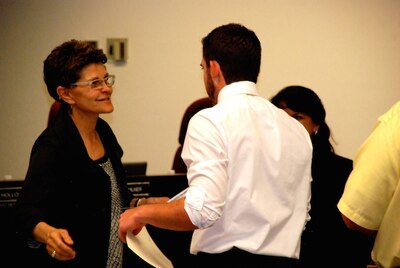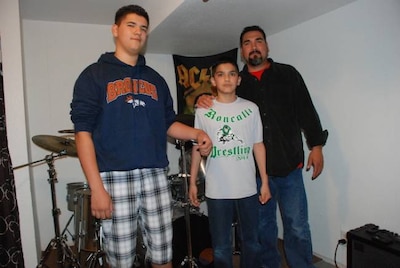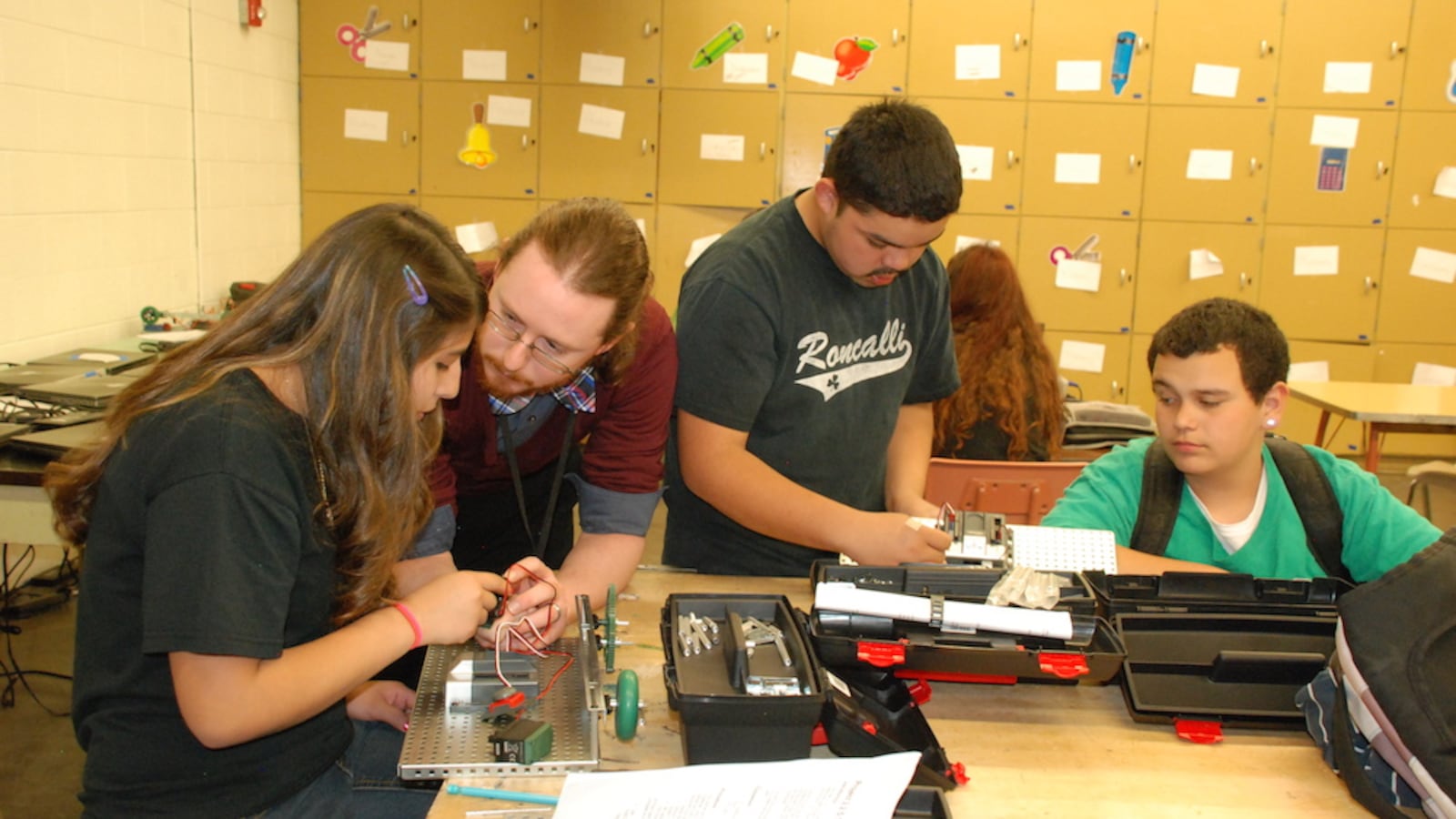PUEBLO — When Tristan Smith was in the sixth and seventh grade at Roncalli Middle School, he often found it difficult to concentrate in class.
Students roamed the hallways, picked fights, and wandered freely through their classrooms. He also found it challenging to concentrate on material that seemed far above his and his classmates’ skill level.
“They taught us some stuff, but it seemed really advanced,” said Smith, who is entering his sophomore year at South High School. “Students didn’t know what they were doing. They were never on task. They were also talking — not really doing anything.”
By the time Smith transferred from Roncalli to a local charter school for eighth grade, he said, the chaos almost seemed normal.
But it quickly became evident to Smith just how far behind he was compared to his new classmates after his transfer to the Chavez Huerta K-12 Preparatory Academy.
This small city’s middle schools have been a blight on its school district, Pueblo City Schools, for years. Even before the state updated how it identifies and tracks failing schools in 2010, it was clear that improving those schools was the district’s biggest challenge.
“We were neglecting that age group,” said Kathy DeNiro, president of the city’s school board who also served in various administrative roles in the school district before retiring in 2007.
Despite a renewed focus on the schools, today much of the district’s struggles to lift itself out of the red zone in the state’s accountability system can be traced to the dismal state of its middle schools. Three of the city’s six middle schools are on the state’s accountability watch list, including Roncalli, which is now the lowest-performing middle school in the state. (Slightly less than half of the city’s elementary and K-8 schools are considered failing, while all four of the city’s high schools are in the safe zone.)
As the state’s accountability clock ticks toward state sanctions for Pueblo, officials are working toward improving its most troubled campuses by offering both additional central support and autonomy to principals.
If the district is able to improve its middle schools, its chances of avoiding state intervention rise significantly. But Pueblo’s recent attempts to better those schools suggest that the task is complex and delicate. The district’s last try, which did yield one popular and high-performing option for Pueblo families, also inadvertently set the stage for the district’s struggles at Roncalli.
And now, according to recent third-party evaluations commissioned by the district and obtained by Chalkbeat, Pueblo’s lowest-performing middle schools still have a long way to go before they can produce the culture and instruction they will need to boost student achievement.
School officials say they just need time, but given the state’s looming deadline — Pueblo might have just a year to significantly boost student test scores or risk intervention — it’s time they may not have.
Building one school, dooming another
Before Roncalli was the state’s lowest-performing middle school, it was one of the city’s most respected.

Sandwiched between two booming middle- and high-income neighborhoods on the city’s south side, the middle school regularly achieved in academics and extracurricular activities from the 1990s to the mid-2000s. At the time, about half of Roncalli’s students came from low-income homes, a share that was about 12 percentage points below the district average.
But despite Roncalli’s successes, by 2007, Pueblo City School officials began to worry about an enrollment dip at the middle school level system-wide. Parents who sent their children to the district’s elementary and high schools looked for alternatives for the middle grades.
So the district hatched a plan to lure students back to public middle schools by creating a high-performing, rigorous, and uncompromising program that would appeal to families. In the fall of 2008, the district rebooted a middle school in one of Pueblo’s poorest neighborhoods that had dwindling enrollment and chronically low scores on state tests. The new school, led by principal Julie Shue, would have a no-nonsense culture, technology in every student’s hands, and a robust international curriculum.
As part of the process of relaunching the school, now known as Corwin International Magnet School, the district redrew its neighborhood school boundaries. Low-income families who had been zoned for Corwin were now sent to either Roncalli or Pitts middle schools, which at that point had less experience educating low-income students.
While Corwin was set up to absorb the neighborhood’s poorer Latino students — and did for its first year — students from more affluent families who had previously attended Roncalli and Pitts who were drawn to Shue’s vision quickly filled the school’s seats.
The result was a rapid influx of low-income students to Roncalli, a demographic shift that often presents huge challenges for schools. While Roncalli saw an overall drop in its enrollment, its share of students poor enough to be eligible for free- or reduced-price lunch jumped 30 percentage points in two years.
Today, 80 percent of Roncalli’s students qualify for free or reduced-price lunches. At Corwin, it’s half that rate, or 41 percent.
“When Corwin [became a magnet school] it caused a significant demographic change at Roncalli,” said Suzanne Ethredge, president of the Pueblo teacher’s union.
And teachers weren’t prepared for that change, union and district officials now concede.
“The piece that might have been missing was — we didn’t prepare the communities well,” said Brenda Krage, the district’s former assistant superintendent.
A 2010 review of the school from the consultant group SchoolWorks bears out that conclusion. The consultants reported that they found little evidence of advance planning to welcome the new students arriving at the school.
That meant two things, the report found. First, tensions developed between Roncalli’s original group of students and the new arrivals from Corwin, leading to escalating behavioral and anger problems.
And secondly, “not all teachers [had] expectations of high levels of student achievement for all students,” the report states. “A lack of rigor and lowered expectations for students to perform at high levels are evident across the school.”
Those deficiencies soon showed up in students’ test scores. Reading scores for low-income students at Roncalli, for example, dropped about 10 percentage points between 2008 and 2009 and their proficiency rates have continued to drop each year, except for a brief bounce in 2010. Last school year, only about one in three poor students of color who attends Roncalli could read at grade level.
Meanwhile, the poor students who remained at Corwin through the transformation to a magnet school benefited greatly from the new economically diverse formation of the school. Reading test scores for black and Hispanic students who qualified for free or reduced-price lunch skyrocketed nearly 40 percentage points and remain high. In 2013, eight in 10 low-income black and Hispanic students at Corwin, about 40 percent of the population, read at or above grade level.
A study in contrasts
Class passing time at Corwin is a quiet and orderly process. Boys in pressed white shirts and ties and girls in neat skirts walk in single file following traffic lanes down the middle of the hallway.

“Everything that happens at Corwin International is deliberate and on purpose,” the school’s principal Shue said.
Shue began to plan all the details of the school about eight months before it opened, travelling the country to observe the best schools and bring their methods back to Pueblo.
Those ideas included a laptop for every student, an International Baccalaureate curriculum, and, perhaps Corwin’s key strategy, mixing students of different skills in the same classroom.
Shue takes the mixing so seriously that, during the school’s second year, she reassigned groups of students to particular lunch periods in order to end the self-segregation between the new Corwin students and the old in the cafeteria she had observed the year before.
There are no prerequisites or entrance exams required to enroll at Corwin, despite what parents believe. But there is a waitlist and an admissions lottery, which gives slight preference to students in the neighborhood. And parents are required to volunteer a dozen hours at the school each semester, potentially dissuading low-income families strapped for time from applying.
Shue believes all students can achieve, “especially in Pueblo.” But she’s not ready now — or if ever — to expand her program past the 650 students it serves today.
“[Corwin] has the perfect balance,” she said. “Bigger does not equal better.”
She just hopes that, for now, her school is an asset to the large school district as it attempts to leap off the state’s accountability watch list.
“Change is one of those things we have to do on purpose,” she said, reflecting on the lessons she learned from re-opening Corwin and a potential lesson for the district.
Roncalli or bust
While students at Corwin reap the benefits of sustained leadership and close attention to the details of school culture, those at Roncalli have floundered under constant leadership turnover — a new principal has been assigned to the school each year since 2008 — and staff who were ill-prepared for the sudden influx of high-needs students.

Despite Roncalli’s poor ratings and weak school culture, Geno Duran is adamant: his children will attend Roncalli Middle School, just as he did. Family traditions are paramount in Pueblo, one of them being their schools. Generations of families have passed through the same hallways of the same campuses for decades.
“It’s convenient and close,” Duran said. More importantly, “I want them to have the same experiences I did.”
But the Roncalli Duran knew in the early 1990s is long gone. At least, the school’s tradition of academic excellence is.
In fact, the Roncalli Duran and his son knew just last year is gone as well.
That’s because part of the school’s innovation plan approved two years ago by the district and State Board of Education called for a completely new teaching staff.
Any staff member who wanted to reapply for their job could. Most didn’t.
Marci Imes was one of the few teachers who returned.
Originally hired for the 2013-14 school year as the dean, Imes was reassigned and became the school’s assistant principal for instruction. When students return to Roncalli on Thursday, she’ll be their new principal, the school’s sixth leader in as many years.
To Imes, Roncalli has made a night-and-day transition in four years: The school has seen an influx of extra cash from state dollars meant to implement its innovation program, as well as grants for its new science and technology focus. Students are more engaged. The new staff is dedicated — and for the most part staying put. The instruction is strong. And a renewed culture is growing.
Some things have not yet improved. The school had more suspensions between Aug. 1 and May 4 than any of the other middle schools. Nearly a third of Roncalli’s 539 students were on average suspended twice for a total of 374 out of school suspensions.
And according to a 2014 review of the school by SchoolWorks, the school still lacks clear goals around student achievement and expectations for students, among other issues.
Classrooms are not structured for learning, the report concluded. When learning does happen, it’s usually at a lower level than what would be needed to push the students forward. Teachers are being asked to cover each others classes during planning time giving up valuable collaboration time. Parent involvement is still low. And there is no consistent policy to to make sure the school’s neediest students.
District leaders say the school and its new staff need more time.
Imes, who was one of the architects behind the school’s innovation plan, is confident that within three years — the timeline the school is using to roll out its science, technology, engineering, and math program — student test scores will improve.
“This is not a one and done,” Imes said. “Becoming a full-fledged STEM school doesn’t happen overnight.”
Complete system failure
While a dramatic demographic shift challenged Roncalli especially, there were far greater systemic problems at work at the city’s other middle schools.

By 2010, when the state introduced its accountability watch list, the city’s middle schools had hit an all time low. Five of the city’s six district-run middle schools were ranked among the state’s lowest-performing. Only Corwin, with its many middle-class families, escaped that designation.
Like at Roncalli, the school district asked school consultant SchoolWorks to identify the symptoms of the district’s low academic performance.
Their findings addressed everything from culture to instruction to professional development of teachers at several of the city’s middle schools.
The results were the same across the school system: Pueblo’s middle schools were toxic.
At Pitts Middle School, in 2009, some teachers did not believe that all children could learn. At Freed Middle School, the principal did not provide teachers feedback after classroom visits. At Risley Middle School, bullying was rampant.
“We had a lot of problems,” said Karen Ortiz, principal of the Pueblo Academy of the Arts, then known as Pitts.
For the last four years Pueblo officials — and some community members of the this Southern Colorado town — have worked to remedy the ills of their middle schools.
Today, the city’s schools have seen mixed results. Two middle schools, Heaton and Pitts, have moved into the state’s safe zone. A third, Risley, is close.
“I hate to say this, but there was a deficient attitude here,” said Charlotte Macaluso, Risley Middle School principal. “Teachers believed no matter what they did, it wouldn’t make a difference. But there’s hope now.”
Updated reports from SchoolWorks, completed last spring, show some improvement in school culture across the district. But instruction, leadership, and quality professional development of teachers are still lacking in critical ways, according to the reports.
Before her retirement, Superintendent Maggie Lopez said the district’s summer professional development for teachers and principals would be centered around improving many of the weaknesses school consultants found, especially concerning instruction.
Hope, not time, runneth over
Jeremy Duran, Geno’s son, sees some of those efforts bearing fruit at Roncalli. This year, fewer students ran in the hallways, he said. There were fewer distractions in the classroom, which meant teachers were no longer yelling as much. And last year he had just one social studies teacher — not three, as the year before.
Math and science were still a struggle for the eighth grader, but he was able to join his peers in mainstream classes rather than smaller classes for students with learning disabilities.
“I’ve made more friends,” he said.
Jeremy is aware of the school’s failing status. “If we don’t get better, the school is going to shut down,” he said.
While no officials have publicly suggested a full shutdown, the Duran family is hopeful the school will make enough strides to stave off drastic changes so that closure could never even be a possibility
After all, the Duran family still has two more students to send through Roncalli: Anthony, a sixth grader, and Kayla, a fourth grader.
And he plans to send them there no matter what happens with the state.
“We’re in it for the long haul,” the Duran patriarch, Geno, said.


